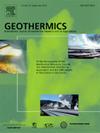Field thermal response experiments of large diameter energy shaft: Applicability comparison between constant heat flow method and constant temperature method
IF 3.5
2区 工程技术
Q3 ENERGY & FUELS
引用次数: 0
Abstract
The field thermal response test is a core technique for obtaining the thermal physical parameters of underground soils. It plays a decisive role in the precise design and energy efficiency optimization of ground source heat pump systems. This study addresses the characteristics of prefabricated energy shafts, which feature large diameters, shallow burial depths, and hollow concrete columns, by overcoming the limitations of conventional buried pipe structures and innovatively designing a cylindrical concrete testing structure. This novel structure achieves comprehensive simulation of actual energy shafts across three dimensions: geometric similarity, material homology, and equivalence in heat transfer mechanisms, significantly enhancing the reliability of test results and their engineering applicability. Through the implementation of two test schemes, namely the constant heat flow method and the constant temperature method, it was revealed for the first time that the differences in soil thermal conductivity and average heat transfer coefficient between the cylindrical concrete structure and the traditional underground pipe structure were as high as 23.72 % and 288 % respectively. This strongly validates the scientific representativeness of the structure for characterizing the thermal transfer properties of energy shafts. The results indicate that the constant heat flux method is advantageous for analyzing thermal physical parameters, whereas the constant temperature method is better suited for measuring heat exchange rate per unit depth. Each method has distinct technical merits and applicable scopes. The outcomes of this research not only establish a standardized technical protocol for thermal response testing of energy shafts, substantially reducing testing costs, but also fill a critical technological gap in the thermal physical testing methodology for prefabricated energy shafts. This work holds significant practical engineering value for advancing low-carbon energy innovations in the building industry.
大直径能量井现场热响应试验:恒热流法与恒温法的适用性比较
现场热响应试验是获取地下土壤热物性参数的核心技术。它对地源热泵系统的精确设计和能效优化起着决定性的作用。本文针对预制能源竖井直径大、埋深浅、混凝土柱中空的特点,克服了传统埋管结构的局限性,创新性地设计了圆柱形混凝土试验结构。该结构实现了对实际能量轴的几何相似性、材料同源性和传热机理等效性三个维度的全面模拟,显著提高了试验结果的可靠性和工程适用性。通过恒热流法和恒温法两种试验方案的实施,首次揭示了圆柱形混凝土结构与传统地下管道结构的土壤导热系数和平均换热系数差异分别高达23.72%和288%。这有力地验证了该结构表征能量轴传热特性的科学代表性。结果表明,恒热流密度法有利于分析热物性参数,而恒温法更适合测量单位深度热交换率。每种方法都有不同的技术优点和适用范围。本研究成果不仅建立了能源轴热响应测试的标准化技术方案,大大降低了测试成本,而且填补了装配式能源轴热物理测试方法的关键技术空白。这项工作对于推进建筑行业的低碳能源创新具有重要的实际工程价值。
本文章由计算机程序翻译,如有差异,请以英文原文为准。
求助全文
约1分钟内获得全文
求助全文
来源期刊

Geothermics
工程技术-地球科学综合
CiteScore
7.70
自引率
15.40%
发文量
237
审稿时长
4.5 months
期刊介绍:
Geothermics is an international journal devoted to the research and development of geothermal energy. The International Board of Editors of Geothermics, which comprises specialists in the various aspects of geothermal resources, exploration and development, guarantees the balanced, comprehensive view of scientific and technological developments in this promising energy field.
It promulgates the state of the art and science of geothermal energy, its exploration and exploitation through a regular exchange of information from all parts of the world. The journal publishes articles dealing with the theory, exploration techniques and all aspects of the utilization of geothermal resources. Geothermics serves as the scientific house, or exchange medium, through which the growing community of geothermal specialists can provide and receive information.
 求助内容:
求助内容: 应助结果提醒方式:
应助结果提醒方式:


